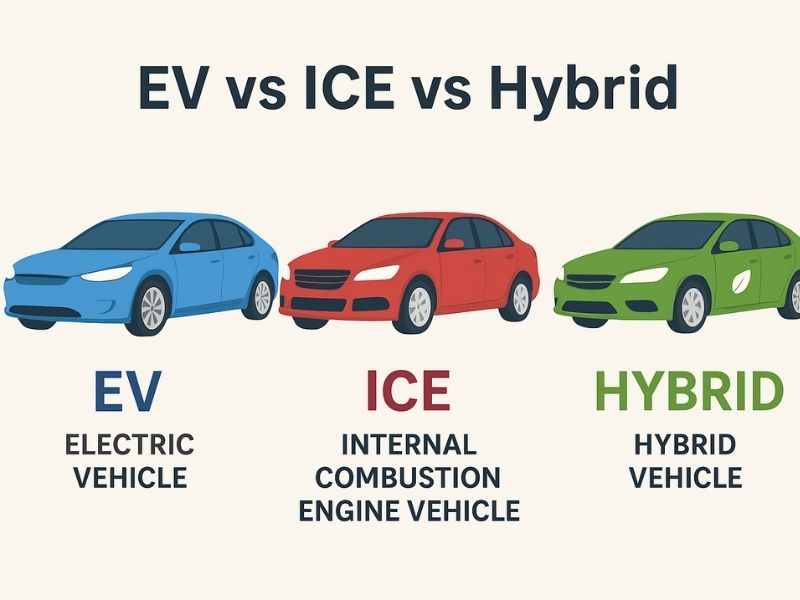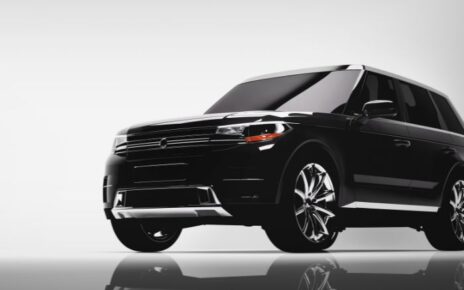When it comes to buying a car today, one of the biggest decisions you’ll face is choosing between EVs (Electric Vehicles), ICE (Internal Combustion Engine) cars, and Hybrid cars. Each type has its own advantages, drawbacks, and future potential. With governments pushing for greener transport and buyers looking for cost savings, this debate is more relevant than ever.
In this blog, we’ll compare EVs, ICE vehicles, and Hybrids in terms of cost, performance, maintenance, environmental impact, and convenience, so you can make a smart choice.
What is an EV (Electric Vehicle)?
An EV runs purely on electricity. Instead of petrol or diesel, it uses a battery pack and electric motor. Popular models include Tesla, BYD, and in India, Tata Nexon EV and MG ZS EV.
Key features of EVs:
- Zero tailpipe emissions
- Powered by rechargeable batteries
- Quiet and smooth driving experience
- Requires charging stations instead of fuel pumps
What is an ICE (Internal Combustion Engine) Vehicle?
An ICE vehicle is the traditional car we’ve known for decades. It runs on petrol or diesel, where combustion happens inside the engine to produce power.
Key features of ICE cars:
- Widely available and familiar
- Quick refueling at petrol stations
- Often has a lower upfront cost compared to EVs
- Large service network and mechanics available everywhere
What is a Hybrid Car?
A Hybrid car combines both an internal combustion engine and an electric motor. The battery gets charged either through regenerative braking or via the engine itself. The Toyota Prius is one of the most popular hybrid cars worldwide.
Key features of Hybrids:
- Better fuel economy compared to ICE cars
- Lower emissions, but not completely zero
- No need for external charging in mild hybrids
- Smooth balance between petrol power and electric drive
EV vs ICE vs Hybrid: A Detailed Comparison
1. Cost and Affordability
- EVs: Higher upfront price due to expensive batteries, but lower running costs (electricity is cheaper than fuel).
- ICE cars: Affordable to buy, but fuel costs are rising. Long-term expenses may be higher.
- Hybrids: Usually more expensive than ICE but cheaper than EVs. Savings come from better mileage.
2. Performance and Driving Experience
- EVs: Instant torque, smooth acceleration, quieter ride. Great for city driving.
- ICE cars: Familiar power delivery, better for long-distance trips where charging isn’t available.
- Hybrids: Balanced performance, better efficiency in stop-and-go traffic.
3. Maintenance and Repairs
- EVs: Fewer moving parts, lower servicing costs, and no oil changes. Battery replacement is expensive, but it is rare, especially with proper care.
- ICE cars: Regular servicing needed (oil, filters, belts). More chances of wear and tear.
- Hybrids: Maintenance cost is slightly higher than that of an ICE because they use both an engine and an electric motor. However, many hybrid car services focus on keeping the dual system in good condition, often at a lower long-term cost compared to high-performance ICE cars.
4. Environmental Impact
- EVs: Zero emissions while driving, but battery production can impact the environment. Best option for reducing pollution in cities.
- ICE cars: Highest emissions, contribute to climate change and air pollution.
- Hybrids: Lower emissions than ICE but not fully green like EVs.
5. Convenience and Infrastructure
- EVs: Dependent on the charging network. Great if you have home charging, but limited stations in rural areas.
- ICE cars: Most convenient, as petrol stations are everywhere.
- Hybrids: No charging worry, but still partly dependent on fuel.
Which One Should You Buy?
- Choose EV if you want to save on running costs, drive mostly in the city, and support eco-friendly technology. Best for urban users with easy access to charging stations.
- Choose ICE if you need an affordable upfront cost, travel long distances often, and live in areas where charging stations are limited.
- Choose Hybrid if you want the best of both worlds — lower fuel bills without worrying about charging infrastructure. Great for people transitioning from petrol to electric.
Future Outlook: EV, Hybrid, or ICE?
By 2030, many countries are planning to phase out ICE vehicles. Hybrids may serve as a bridge technology, but the future is clearly electric. Battery costs are falling, charging infrastructure is expanding, and EV technology is improving every year.
For now, the decision depends on your budget, driving habits, and location. But in the long run, EVs will dominate the roads.
Final Words
The EV vs ICE vs Hybrid debate is not just about cars; it’s about lifestyle, cost, and the environment. If you’re buying a new car in 2025, consider where you live, how far you travel daily, and your budget. While EVs are the future, Hybrids are the middle path, and ICE cars are the traditional choice, you should also think about the availability of car repair shops and service centers in your area. Whichever you choose, make sure it fits your needs and long-term goals.
Also Read: Car Wrap vs Paint: Which One Lasts Longer in Australian Weather?




